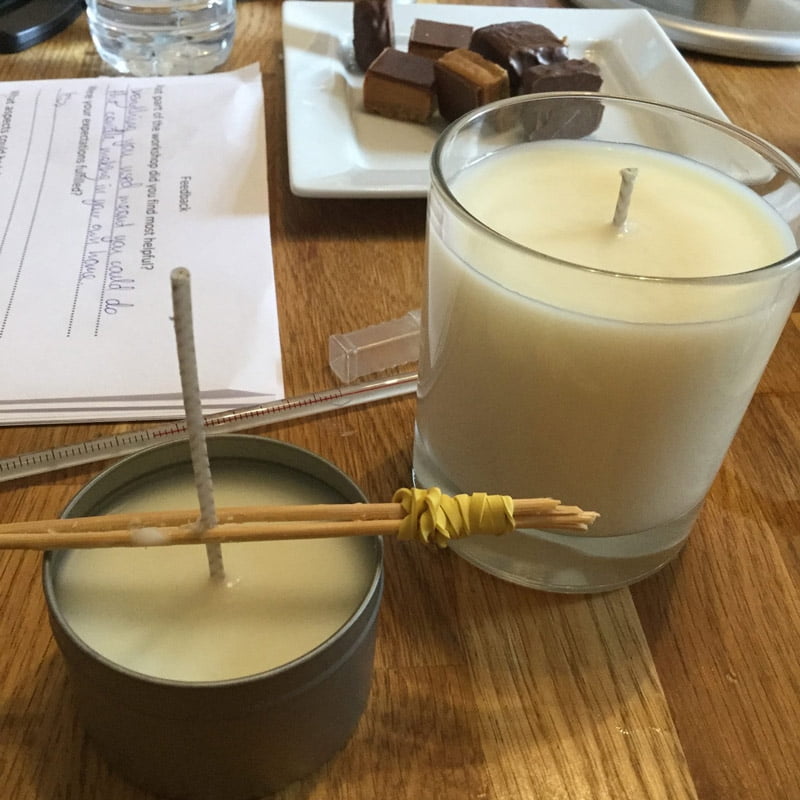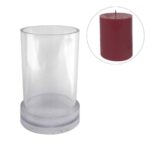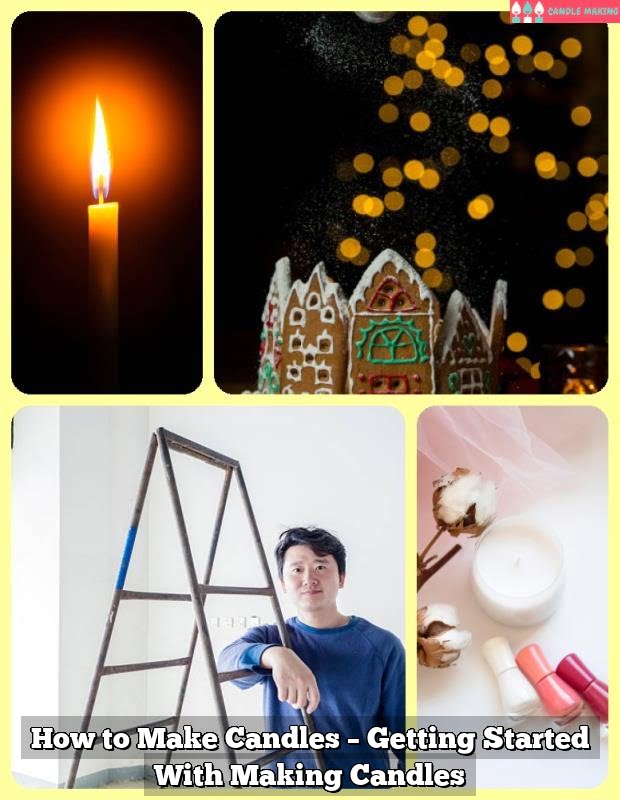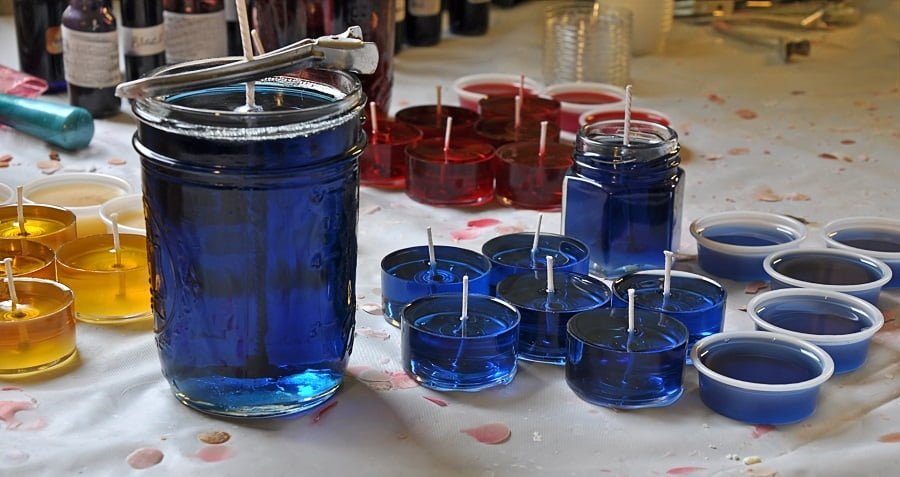If you’re looking for a new hobby that allows you to express your creativity and potentially earn some extra income, candle making could be the perfect choice for you. Making candles at home has become increasingly popular in recent years, as people have discovered the countless benefits of this craft.
Whether you’re interested in creating beautiful scented candles for yourself or starting a small business selling homemade products, learning how to make candles is a rewarding and enjoyable endeavor.
Candle making offers a unique combination of relaxation and creativity. It provides a satisfying outlet for self-expression, allowing you to experiment with different colors, fragrances, and designs. The process of melting wax, adding fragrance oils, and pouring the mixture into molds can be incredibly therapeutic and calming. And once your candles are finished, you’ll have beautifully crafted pieces that not only enhance the ambiance of any room but also make thoughtful gifts for friends and family.
In addition to being a fulfilling hobby, making candles has the potential to generate extra income. With the increasing demand for handmade goods and unique gift items, there is always a market for high-quality homemade candles.
By mastering the art of candle making, you can turn your passion into a viable business opportunity. Whether you choose to sell your products online or through local markets and craft fairs, there is ample potential for growth and success in the candle-making industry.
In this article, we will explore all aspects of candle making: from the different types of candles you can create to the necessary supplies and tools required for the craft. We will guide you through each step of the candle-making process, provide important safety precautions to ensure your wellbeing while working with hot wax, offer techniques for incorporating fragrance and color into your creations, and provide creative ideas for decorating your finished candles.
Additionally, we will address common issues that may arise during the candle-making process and provide resources where you can purchase supplies and further enhance your skills.
Get ready to embark on an exciting journey into the world of candle making, where your creativity can flourish, and your sense of achievement will soar. Whether you plan to make candles as a hobby or aspire to turn it into a profitable business venture, this article will equip you with all the knowledge and skills you need to get started.
So let’s dive in and discover the art of making beautiful, fragrant candles right in the comfort of your own home.
The Benefits of Making Candles at Home
Making candles at home can be an incredibly fulfilling and rewarding hobby. Not only does it provide a creative outlet for self-expression, but it also has the potential to become a source of income. Here are some of the benefits of engaging in candle-making as a hobby and business opportunity:
- Creative Outlet: Making candles allows you to express your creativity in various ways. From choosing different scents and colors to experimenting with unique designs and decorations, there are endless possibilities for creating one-of-a-kind candles that reflect your personal style.
- Relaxation and Stress Relief: The process of making candles can be very therapeutic and relaxing. The calmness of melting wax, mixing fragrances, and pouring the hot liquid into molds can help relieve stress and promote mindfulness.
- Personalized Gifts: Handmade candles make thoughtful gifts for family and friends on special occasions. You can customize them according to the recipient’s preferences by selecting their favorite scents or incorporating symbolic designs.
- Potential Business Opportunity: If you enjoy making candles and want to turn your hobby into a small business venture, there is a growing demand for handmade candles in the market. With proper branding, marketing strategies, and high-quality products, you can create a successful business selling your creations online or at local craft fairs.
Starting a candle-making business from home has several advantages:
- Low Startup Costs: Compared to other businesses, starting a candle-making venture requires minimal investment in equipment and materials.
- Flexibility: You have complete control over your schedule, allowing you to work at your own pace or accommodate other commitments.
- Scalability: As your skills improve and demand increases, you have the opportunity to expand your product range or production capacity.
- Personal Fulfillment: Building a successful business from something you love doing brings immense satisfaction and fulfillment.
Whether you are looking for a creative outlet or considering venturing into entrepreneurship, making candles at home offers numerous benefits that can bring joy, relaxation, and even financial rewards. So why not give it a try and see where this hobby takes you?
Types of Candles
Candle-making is a versatile craft that allows you to create a wide range of candle types, each with its own unique characteristics and uses. Whether you are making candles for personal enjoyment or considering starting a candle-making business, it is important to have an understanding of the different types of candles available. This section will provide a detailed overview of various candle types, such as container candles, pillar candles, votive candles, and more.
Container candles are one of the most popular types of candles because they are easy to make and versatile in design. As the name suggests, these candles are poured into containers such as jars or tins, which serve as both the mold and the vessel for burning the candle.
Container candles can be made using a variety of waxes such as soy wax, beeswax, or paraffin wax, depending on your preference. They are known for their long burn times and ability to retain fragrance well.
Pillar candles are another common type of candle that are characterized by their cylindrical shape and lack of an external container. These candles are typically freestanding and can be made in varying heights and widths. Pillar candles can be made using different techniques such as pouring melted wax into a mold or building layers of wax sheets around a wick. They are known for their decorative appeal and can make beautiful centerpieces or display pieces.
Votive candles are small-sized cylindrical or tapered candles that are designed to be burned in a votive holder for stability. These candles are often used in religious ceremonies or as decorative accents in homes. Votive candles can be made using different kinds of waxes and colors, allowing for endless creative possibilities.
| Candle Type | Description |
|---|---|
| Container Candles | Easy to make, poured into containers such as jars or tins |
| Pillar Candles | Cylindrical shape, made without an external container |
| Votive Candles | Small-sized cylindrical or tapered candles burned in a votive holder for stability |
In addition to these common candle types, there are also specialty candles such as taper candles, tea lights, and floating candles that offer unique design possibilities. By exploring the different types of candles available, you can choose the ones that align with your creative vision and goals.
Necessary Supplies and Tools
When it comes to making candles, having the necessary supplies and tools is essential for a successful and enjoyable experience. Here is a comprehensive list of the essential materials required for making candles:
- Waxes: The most common type of wax used for candle-making is paraffin wax. However, there are also other options available such as soy wax, beeswax, and palm wax. Each type of wax has its own unique qualities and advantages, so it’s worth experimenting with different ones to find your preferred choice.
- Fragrance Oils: Adding fragrance to your candles can enhance the overall sensory experience. There are countless fragrance oils available in various scents such as lavender, vanilla, citrus, and many more. Make sure to choose high-quality fragrance oils specifically designed for candle-making.
- Wicks: The wick is what provides the fuel for the flame in a candle. It’s important to select the right wick size based on the diameter of your container or mold. Too large of a wick may cause excessive heat and soot, while too small of a wick may result in poor burning performance.
- Molds: Depending on the type of candles you want to make, you will need different types of molds. For container candles, you can use glass jars or tins as molds. Pillar candles require specialized molds that are usually made from aluminum or silicone. Votive candles can be made using metal or plastic votive molds.
- Thermometers: Maintaining the correct temperature during the candle-making process is crucial for achieving optimal results and ensuring safety. A thermometer is necessary for accurately monitoring the temperature of both the melted wax and any additives being used.
- Double Boiler: To safely melt your wax without direct heat, it is recommended to use a double boiler setup. This consists of a heat-resistant container filled with melted wax placed inside another pot filled with water that is being heated on a stove.
- Pouring Pitcher: A pouring pitcher with a spout is useful for pouring the melted wax into your molds or containers. It allows for precise and controlled pouring, reducing the chances of spills or accidents.
- Heat Source: You will need a heat source, such as a stove or an electric melting pot, to melt the wax and maintain the proper temperature throughout the candle-making process.
- Miscellaneous Tools: Other tools that may come in handy include a scale for weighing wax and additives, a stirrer or spoon for mixing ingredients, and a heat-resistant mat or surface to protect your workspace from hot wax spills.
- Safety Equipment: Don’t forget about safety. It’s important to have proper safety equipment such as heat-resistant gloves, safety goggles, and aprons when working with hot wax and potentially hazardous materials.
By having these essential supplies and tools on hand, you will be well-prepared to embark on your candle-making journey. Experimenting with different materials and techniques can lead to endless possibilities in creating unique and beautiful homemade candles.
Step-by-Step Candle Making Process
Making candles can be a fun and rewarding hobby that also offers the potential for a lucrative business opportunity. If you’re interested in diving into the world of candle making, it’s important to familiarize yourself with the step-by-step process involved. This section will provide a detailed walkthrough of the entire candle-making process, from selecting the right waxes and additives to pouring and curing the candles.
- Selecting the Right Waxes: The first step in making candles is choosing the right waxes for your project. There are various types of waxes available, including soy wax, beeswax, paraffin wax, and gel wax. Each type has its own unique qualities and characteristics, so it’s important to understand their differences before making a decision. Consider factors such as burn time, fragrance retention, and appearance when selecting your wax.
- Adding Additives: Depending on the type of candles you want to make, you may need to add certain additives to achieve specific effects. Additives can be used to enhance fragrance throw, increase hardness or opacity, or improve burn quality. Some commonly used additives include stearic acid for increasing opacity and hardness, vybar for improving fragrance throw in scented candles, and UV absorbers for preventing color fading.
- Choosing Fragrances: One of the most enjoyable aspects of making candles is adding scents to create unique products. There is a wide variety of fragrance oils available that can be used in candle making. It’s important to choose fragrances specifically formulated for use with candles to ensure optimal performance. When selecting fragrances, consider factors such as compatibility with the chosen wax type and desired strength of scent throw.
- Wicking Your Candles: The wick plays a crucial role in how well your candle burns. Choosing the right wick size is essential for achieving an even burn pool without tunneling or excessive smoking. The ideal wick size depends on various factors such as diameter of the candle, type of wax, and presence of additives. It may require some trial and error to find the perfect wick size for your candles.
- Pouring and Curing: Once you have prepared your wax by adding any necessary additives and fragrances, it’s time to pour it into your chosen containers or molds. Be sure to follow the manufacturer’s instructions for temperature guidelines, as pouring at too high or too low a temperature can affect the burn quality of the candle.
After pouring, allow sufficient time for the candles to cure before lighting them. This typically involves letting them cool and harden for a period of 24 to 48 hours.
Following these steps will help you create beautiful and well-performing candles. Remember to take your time, experiment with different techniques, and have fun throughout the process. With practice, you’ll become more skilled and confident in your candle-making abilities.
Candle Safety Precautions
When it comes to candle making, safety should always be a top priority. Working with hot wax, open flames, and potentially hazardous materials can pose risks if proper precautions are not followed. This section will provide crucial information on the safety measures and precautions that should be taken when engaging in candle-making.
Protective Gear
Before you start making candles, it is important to protect yourself by wearing appropriate protective gear. This includes wearing long sleeves and pants to cover your skin and closed-toed shoes to protect your feet from hot wax spills. Additionally, wearing gloves can provide an extra layer of protection against burns.
Working Area
Creating a safe working area is essential for candle making. Make sure you set up your workspace in a well-ventilated area to avoid inhaling fumes from fragrance oils or other additives. Keep your work surface clean and clear of any clutter that could potentially cause accidents.
Fire Safety
Since candles involve an open flame, fire safety precautions should be taken seriously. Never leave lit candles unattended and keep them away from flammable materials such as curtains or furniture. Always have a fire extinguisher nearby and learn how to use it properly in case of emergencies.
Handling Hot Wax
Hot wax can cause severe burns if not handled with caution. Take extra care when melting the wax and ensure you have a heat-resistant container to pour it into. Use appropriate tools such as double boilers or electric melters to prevent direct contact with the hot wax.
First Aid Kit
Accidents can happen even with all the necessary precautions in place. It is important to have a first aid kit readily available in case of minor injuries such as burns or cuts. Familiarize yourself with basic first aid procedures for treating such injuries before starting your candle-making journey.
By following these safety precautions, you can enjoy the candle-making process while minimizing the risks associated with it. Remember, safety should always come first to ensure a rewarding and accident-free experience.
Adding Fragrance and Color to Candles
Adding Fragrance to Candles
One of the most appealing aspects of homemade candles is the ability to customize them with unique scents. Adding fragrance to your candles not only enhances their aesthetic appeal but also creates a multi-sensory experience that can be incredibly captivating. There are several methods and techniques for incorporating scents into your homemade candles, each offering its own advantages and considerations.
Choosing Fragrance Oils
When it comes to adding fragrance to your candles, one popular option is using fragrance oils. These oils are specifically formulated for candle-making and provide a wide variety of fragrances to choose from. To ensure a good scent throw, opt for fragrance oils that are specifically labeled as suitable for candle making.
Start by selecting a scent that complements the overall theme or purpose of your candle. Whether you prefer floral, fruity, or woody aromas, there is bound to be a fragrance oil that suits your preferences.
Blending Fragrances
For an even more personalized touch, consider blending different fragrance oils together to create custom scents. By combining two or more fragrances, you can achieve unique combinations that are truly one-of-a-kind. Experiment with different ratios until you find the perfect blend that appeals to your senses. Keep in mind that some fragrances may overpower others, so start with small amounts when testing out new blends.
Incorporating Color into Candles
Color plays a significant role in the overall look and feel of your homemade candles. It can enhance the visual appeal and complement the chosen scent. There are various methods and materials available for adding color to your candles, depending on the type of wax you’re using and the desired effect.
Liquid Candle Dyes
One common method of coloring candles is by using liquid candle dyes. These dyes are highly concentrated pigments specifically designed for candle-making purposes. They come in a wide range of colors and allow you to achieve vibrant hues with just a few drops.
Liquid candle dyes are often preferred for their ease of use and ability to blend well with different waxes. When using liquid dyes, always follow the recommended guidelines for the appropriate dye-to-wax ratio to ensure an even and consistent color.
Color Blocks or Chips
Alternatively, you can use color blocks or chips that are specifically designed for candle making. These solid pigment blocks are typically made from a mixture of dyes, wax, and additives, resulting in concentrated colors that dissolve easily into the melted wax. Color blocks offer the advantage of easy measurement and less mess since they don’t require precise measurements like liquid dyes.
Natural Coloring Agents
If you prefer a more natural approach, you can also explore using natural coloring agents such as herbs, spices, or even flowers. For example, adding ground cinnamon can create warm earthy tones while dried lavender buds can impart a delicate purple hue. However, it’s important to note that natural coloring agents may affect the burn characteristics of your candles and may not provide as vibrant colors as synthetic options.
Whether you’re adding fragrance oils or incorporating colors into your candles, experimentation is key to finding the perfect combinations that align with your creative vision. Take time to explore different scents and shades to create unique and enticing products that will delight both yourself and anyone fortunate enough to experience your homemade candles.
Creative Candle Decoration Ideas
When it comes to candle making, the creative possibilities are endless. Adding unique decorations to your candles can elevate them from simple objects to works of art. In this section, we will explore various creative candle decoration ideas that will inspire you to personalize and embellish your candles.
One popular technique for decorating candles is marbling. Marbling involves creating intricate patterns on the surface of the candle using different colors of melted wax. To achieve this effect, melt small amounts of colored wax in separate containers. Once melted, carefully pour the colored wax onto the surface of the candle in a random pattern. Then, use a toothpick or skewer to swirl the colors together, creating a marbled effect. Allow the wax to cool and harden before lighting.
Another way to personalize your candles is by embedding objects into them. This could be anything from dried flowers and herbs to small trinkets or even gemstones. Before pouring the melted wax into the container or mold, place your chosen object at the bottom. Slowly pour the wax over it, making sure it covers the object completely. As the wax cools and solidifies, you will have a beautiful surprise embedded within your candle.
Candle wraps are another popular option for decoration. These pre-printed pieces of paper or fabric are designed specifically to wrap around candles and add a decorative touch. Candle wraps come in a variety of designs, from intricate patterns to holiday themes, allowing you to easily customize your candles for any occasion.
By using these creative decoration techniques and experimenting with different materials and designs, you can create one-of-a-kind candles that make perfect gifts or eye-catching pieces for your own home decor.
Troubleshooting Common Candle-Making Issues
One of the most rewarding aspects of candle making is seeing your finished product burn evenly and beautifully. However, sometimes issues can arise during the candle-making process that prevent this from happening. In this section, we will explore some common problems that may occur and provide troubleshooting tips to help you overcome them.
Uneven burning is a common issue faced by candle makers. This occurs when one side of the candle burns faster or more intensely than the other, resulting in an uneven wax pool. To tackle this problem, it is important to ensure that you are using the right type and size of wick for your chosen wax and container.
A wick that is too small may not be able to create enough heat to burn evenly, while a wick that is too large could cause an excessive flame and uneven burning. Additionally, placing your candles in drafty areas can also lead to uneven burning, so make sure to position them away from any open windows or vents.
Another issue that often arises is frosting. Frosting appears as a white or cloudy film on the surface of your candles and can detract from their overall appearance. It occurs when the wax cools too quickly and crystallizes. One way to minimize frosting is by pouring your candles at a slightly higher temperature than recommended for your specific wax type. Additionally, allowing your candles to cool gradually in a consistently warm environment can also help reduce frosting.
Tunneling is yet another common problem faced by candle makers. This happens when the candle burns down in a tunnel-like shape instead of melting all the way to the edges of the container. Tunneling is usually caused by not allowing enough time for the initial burn during the first use of the candle.
To avoid this issue, remember to keep your candles lit for at least one hour per inch in diameter during their first burn. This will allow them to form an even wax pool from edge to edge, preventing tunneling in subsequent burns.
By following these troubleshooting tips, you can overcome common candle-making issues and achieve the desired results for your candles. Remember, practice makes perfect, so don’t be discouraged if you encounter problems along the way. With patience and experience, you’ll become a master candle maker in no time.
Resources and Where to Buy Supplies
In conclusion, finding reliable suppliers for candle-making materials is crucial to ensure the quality of your products. When it comes to purchasing supplies, it is important to do thorough research and choose suppliers who offer high-quality waxes, fragrance oils, wicks, molds, thermometers, and other necessary tools. Online platforms such as Etsy and Amazon have a wide selection of suppliers that cater to different needs and budgets.
Additionally, it can be beneficial to join online communities or forums dedicated to candle-making. These communities provide a wealth of knowledge and support from experienced candle makers who are willing to share tips, techniques, and troubleshooting advice. Participating in discussions and asking questions within these communities can help you expand your understanding of the craft and build connections with fellow enthusiasts.
Furthermore, consider exploring additional resources such as books and online courses to further enhance your candle-making skills. Books written by experts in the field can provide valuable insights into advanced techniques, unique designs, and industry trends. Online courses offer a structured learning experience with hands-on demonstrations and guidance from experienced instructors.
By utilizing these resources and building relationships with trustworthy suppliers, you can continue to develop your candle-making skills and potentially turn your hobby into a successful business venture. Remember to always prioritize safety precautions when working with hot wax and open flames, as well as experiment with different scents, colors, decorations, and troubleshooting techniques to achieve truly unique candles that stand out in the market.
Frequently Asked Questions
How do you start making candles for beginners?
To start making candles as a beginner, you will need some essential materials and equipment. First, decide on the type of wax you want to use – options include soy wax, beeswax, or paraffin wax. Next, gather a double boiler or a melting pot, a thermometer to monitor the temperature, wicks suitable for your chosen wax, fragrance oils or essential oils for scenting the candles, and coloring agents if desired. Additionally, you will need containers or molds to shape your candles and tools like a wick holder or centering device.
Begin by melting the wax in the double boiler or melting pot over low heat until it reaches the recommended temperature for your chosen wax. Add color and fragrance as desired while ensuring they are well-mixed. Lastly, carefully pour the melted wax into containers or molds with pre-cut wicks placed at the center. Allow the candles to cool and set before trimming the wicks.
Is candle making profitable?
Candle making can be profitable; however, it depends on various factors such as market demand, quality of your products, production costs, pricing strategies, and marketing efforts. The candle industry is highly competitive with a wide range of products available on the market. It’s important to focus on creating unique and high-quality candles that stand out from the competition to attract customers.
Building brand awareness through effective marketing channels like social media platforms or local markets can also contribute to profitability. Additionally, keeping production costs under control by sourcing materials at reasonable prices and optimizing processes can help maximize profits in candle making.
How much money do you make making candles?
The amount of money one can make by making candles varies greatly depending on several factors. These include factors such as the scale of production (whether it’s a small home-based venture or a larger operation), pricing strategy (premium pricing vs competitive pricing), overhead costs (rental space costs if applicable), material expenses (such as wax, fragrances, containers), labor costs (if hiring staff), and market demand for the candles.
It’s important to carefully consider all these factors when setting prices and estimating potential earnings from candle making. Profitability can vary from a small side income to a substantial source of revenue if the business is run efficiently, and there is strong demand for the products.

Welcome to my candle making blog! In this blog, I will be sharing my tips and tricks for making candles. I will also be sharing some of my favorite recipes.





